|
Please click here to support the Heritage Act
It has been touted the world over as the first example of the Indo-Saracenic style of architecture, a style for which Madras became famous. And yet, in the absence of any form of legislation to protect buildings of its kind, historic Chepauk Palace is rapidly going to seed and, unless something fairly urgent is done about it, this historic precinct is unlikely to survive long. That at least was the impression I was left with during a recent visit to the premises.
Chepauk Palace was built as the city residence of the Nawabs of Arcot. Probably designed by Paul Benfield, a Company engineer turned building contractor, it was the first instance anywhere in the world of the Indo-Saracenic style. It also, more famously, marked the beginning of the takeover of the Carnatic by the British and, when it was nearing completion, it was evident to most that the days of the Nawabs’ rule were numbered. Sure enough, the Carnatic was annexed in 1801 though the ruling family was permitted to use the palace till 1855 when, on the pretext of liquidating the debts of the Nawabs, the palace was acquired by the Government in a sham auction. Since then, it has been used by Government departments, of which the best-known are the Revenue and Public Works Departments. The latter also has its own independent wing fronting Chepauk Palace, built by Robert Fellowes Chisholm.
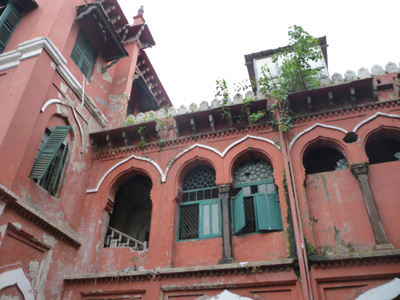
Tree growth has a field day at Chepauk Palace with its broken windows and what fills in for them when they have vanished.
|
Chepauk Palace’s long decline began in the 1950s when the Government decided to build Ezhilagam to house many more of its departments. The new edifice completely cut off the Palace from public view, at least from Beach Road, a view that many early writers on the city claimed was the one which showed the buildings at their best. But a worse blow was to follow in the 1980s when the Agriculture Department offices were built, despite protests, on the Wallajah Road side of the Palace. This meant that the Palace could only be seen and accessed from the rear. And to add to the damage, an aerial corridor was built connecting the old Palace to the new building, for which a gaping hole had to be made in the historic walls. But all this fades into insignificance in the face of the wanton neglect of the palace, which has caused untold damage to it.
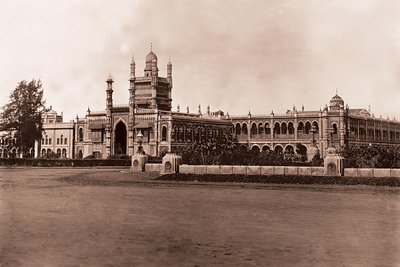
Chepauk Palace as seen c. 1900. (Courtesy: Vintage Vignettes.)
|
As offices proliferated inside the Palace, toilets have been built any-which-way-you-please. There are water tanks on the roof, which seep and add to the damage. Maintenance is shoddy and posters are pasted all along the walls of the buildings, at least up to the height that human hands can reach. Trees are now growing on the walls and several chunks of ornamental plasterwork have come off. There are unsightly grilles, ostensibly to provide security to what is ironically used as a free thoroughfare connecting Wallajah and Kamaraj Roads! A family appears to have made the rear portico its home and when I walked by, an old man among the squatters came up and demanded that the building be soon demolished and rebuilt with modern amenities! A yard on the side is filled with discarded furniture, all of it awaiting an uncertain fate. There are also vast rubbish tips in the courtyards.
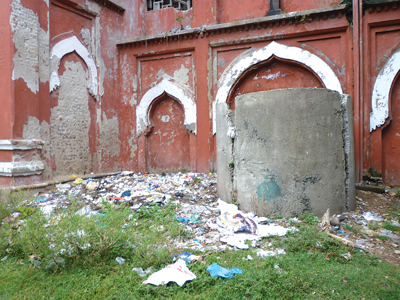
A garbage dump lying untended beside deteriorating walls.
|
Inside, it would be no exaggeration to state that the various department files are holding on the roof. There are towers made of office files and there are steel cupboards which serve as walls and which are dragged about the old flooring – leaving permanent scratch marks. Parts of the roof collapsed a few years ago owing to prolonged neglect of the wooden beams that held the roof on. The offices in these sections have been shifted but nothing has been done to repair the damage and these portions remain as they are, adding to the wear and tear.
It is quite evident that the Palace is crying for restoration and if this is denied or even delayed, we may not have the buildings with us for long. A few years ago, a restoration project was announced but it is not clear as to what became of it. The Palace, however, did get a fresh coat of paint. But that can hardly hide the obvious signs of stress. And, so, Chepauk Palace joins the rather long line of heritage buildings in the city that are in urgent need of some loving care. Given its importance, it will hopefully charge ahead of others in the queue.
But, in the absence of a Heritage Act, are we likely to see any action? Or, is the Government waiting for the buildings to weaken? Then it will be very easy to get a certificate from one of its own departments to the effect that the building is “unfit for habitation” and the rest of the procedure will follow – another new Government-built monstrosity with more offices and piles of files, built over another graveyard of history.

Temporary storage facilities built along the palace walls
|
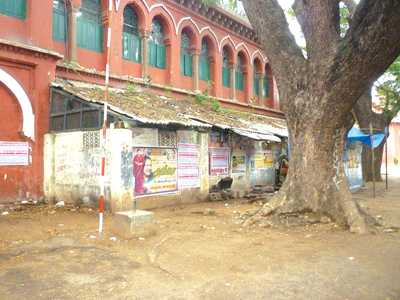
A permanent toilet block.
|
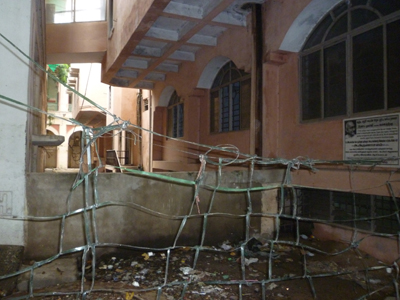
New buildings that have come up to completely shut out the palace. Note the tangle of wires.
|
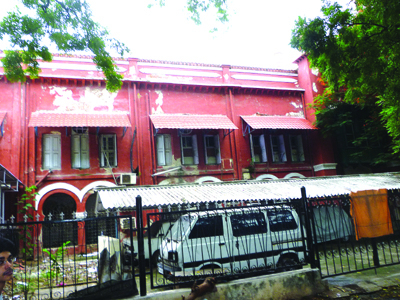
Temporary van shelters and corrugated iron sunshades for windows. Note the state of the walls.
|
|